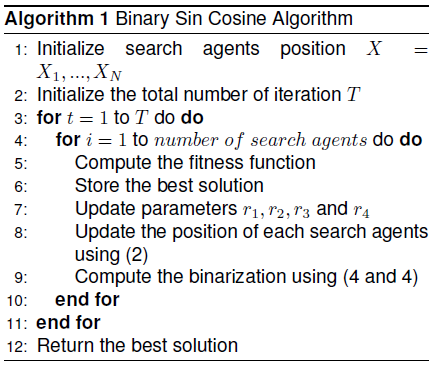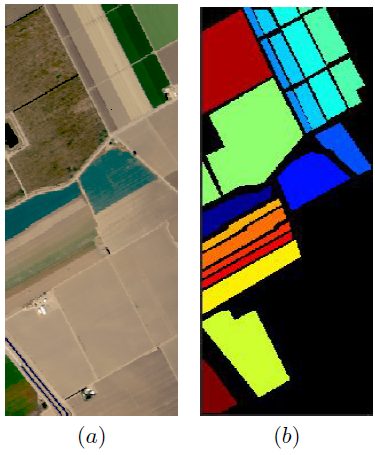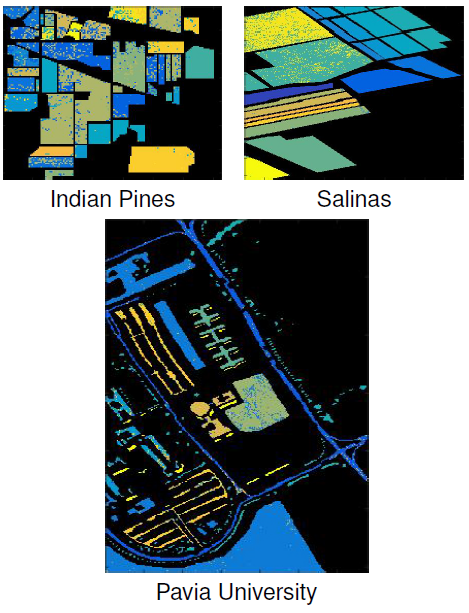1 Introduction
Hugh phenomenon is one of the major challenge problem in hyperspectral image classification [9,4,13]. Because the large number of bands and highly correlated bands, several problems are present such as low quality of classification map, difficulty of processing, etc. To avoid the curse dimensional problem and reduce computational time, the band selection methods are used. The aims of band selection are to select an optimal band subset by removing the highly correlated band, irrelevant and non-informative bands [6,9,5].
Generally, feature selection approaches are subdivided into two categories. The first category is known as filter approach [7]. This category uses a statistical measure to compute the importance of a feature and it is independent of any classification method. Therefore, the features are selected based on their statistical score. Among the filter approaches, we cite: Relief, independent component analysis (ICA), principal component analysis (PCA), minimum redundancy maximum relevance (mRmR), mutual information maximization (MIM), factor analysis (FA), conditional informax feature extraction (CIFE), mutual information feature selection (MIFS), fast correlation-based filter (FCBF), etc. [12,1].
The second category of feature selection approaches is wrapper approach. In this category, the problem of feature selection is regarding as a search problem and it uses generally machine learning methods to measure the importance of a subset of candidate features [7,3,11]. Among these approaches, we cite, BPSO-feature selection [8], Simulated Annealing-Support Vector Machine [7], Grey Wolf Optimizer for Band Selection [9], Binary Bat Algorithm for Feature Selection [11], etc.
The difference between filter and wrapper approaches can be summarized in these points: filter approach measures the importance of feature individually, the wrapper approach measures the relevance of a feature subset using training model. Also, wrapper approach provides in many cases the best subset of features but the risk of overfitting is high.
In this paper, we propose a new hybrid band selection approach to reduce the highly correlated bands which are neighbors and the irrelevant bands. This approach is based on two steps, firstly, we merge the adjacent bands which are highly correlated and secondly, we select a subset of bands that provides a high classification accuracy. Three hyperspectral images widely used in the literature will be considered to test the performance of the proposed approach. The rest of paper is organized as follows: in section 2, we detailed the proposed approach, in section 3, the experimental results are presented and conclusions are given in section 4.
2 The Proposed Band Selection Approach
The proposed approach is essentially based on two important steps. Figure 1 illustrates the proposed approach for band selection.
2.1 First Step
The first step consists to decrease the number of bands by merging the adjacent bands which are considered as highly correlated. We compute the Pearson correlation coefficient between adjacent bands. Considering the set of bands B={b1,..., bN}. The correlation coefficient is defined as follows:
where ρ is the Pearson correlation between the bands
bi and bj. σ is the
variance and
Two bands bi and bj re considered as highly correlated if the Pearson correlation coefficient is close to 1. This indicates that the adjacent bands bi and bj are strongly linear dependency.
For merging, we propose to take the average value between each pixels the two images. Figure 2 summarizes the first process.
2.2 Second Step
The second step consists to select from the subset of bands provided by the first step the optimal band subset. For this process, we propose to use a wrapper approach based on Sin Cosine Algorithm. The basic idea is using SCA to optimize the classification accuracy [10].
Sine Cosine Algorithm is an optimization algorithm developed by Seyedali Mirjalili [10]. SCA generates a set of random solutions called search agents, which are evaluated using the fitness function.
This algorithm uses a mathematical schema based on sin and cosine functions to designed the position updating [10]. This model is defined as follows:
where r1, r2, r3 and r4 are random numbers.
r1 is used to perform an exploration or exploitation and it is defined as follows:
where T is the total number of iteratin, t is the current iteration and a is a constant, r2 defines the direction of the movement, r3 provides a random weight, r4 is a random variable between 0 and 1 using to choose between sin and cosine function [10].
A binary version of SCA algorithm is proposed. This binary version uses the transfer function defined on [2]. The transfer function allows to mapping ℝ solution in [0,1] solution and it given as follows:
Where β is a random variable between 0 and 1. In this case, if vi=1 then the band bi is used, otherwise, the band bi is removed.
The pseudo code of binary CSA algorithm is described as follows:
The fitness function used in this study is the classification accuracy rate provided by k nearest neighbor (k-NN).

3 Experimental Results
To assess the performance of the proposed approach, we conduct the experimentation on three publicly available benchmark hyperspectral images called: Indian Pines, Salinas and Pavia University.
Indian Pines is a hyperspectral image acquired by AVIRIS sensor over the Indian Pines, Northwestern, Indiana, USA. It is 145 × 145 pixels and 224 bands taken in the wavelength range 0,4-2,5 μm. The classes of this images are: Alfalfa, Corn-notill, Corn-mintill, Corn, Grass-pasture, Grass-trees, Grass-pasture-mowed, Hay-windrowed, Oats, Soybean-notill, Soybean-mintill, Soybean-clean, Wheat, Woods, Buildings-Grass-Trees-Drives, and Stone-Steel-Towers.
Salinas is hyperspectral image taken by AVIRIS sensor over Salinas Valley, California, USA. It is 512 × 217 pixels and composed of 224 bands taken in the wavelength range 0,4-2,5 μm.
It composed of 16 classes: Broccoli-green-weeds-1, Broccoli-green-weeds-2, Fallow, Fallow-rough-plow, Fallow-smooth, Stubble, Celery,Grapes-untrained, Soil-vinyard-develop, Corn-senesced-green-weeds, Lettuce-romaine-4wk, Lettuce-romaine-5wk, Lettuce-romaine-6wk, Lettuce-romaine-7wk, Vineyard-untrained and Vineyard-vertical-trellis.
Pavia University is acquired over University of Pavia, Italy. The size of this image is 610 × 340 pixels and it composed of 103 bands taken in the wavelength range 0,43-0,86 μm. It composed of 9 classes: Asphalt, Meadows, Gravel, Trees, Painted Metal Sheets, Bare Soil, Bitumen, Self-Bloking Bricks, and Shadows.
3.1 Parameters Settings
The parameters of the proposed approach are adjusted as follows: 10% of pixels are used for training. 40% of pixels are used for testing and the rest 50% of pixels are used for validation phase.
For the first step, we consider two adjacent bands highly correlated if the Pearson correlation coefficient is greater than 0,97.
For the second phase, the binary CSA algorithm is set as follows: we use 30 search agents and 500 iterations. The fitness function is the classification accuracy rate provided by k-NN classifier using the Euclidean distance and k = 7.
3.2 Results and Discussions
The assess of the proposed approach is conducted in term of overall accuracy (OA), average accuracy (AA), individual class accuracy (ICA) and the number of selected bands. The results are described in tables 1, 2 and 3.
Table 1 OA (%), AA (%) and ICA (%) obtained by the proposed approach applying on Indian Pine
| Class | Classification all bands |
This approach | |
|---|---|---|---|
| Step 1 | Step 2 | ||
| Alfalfa | 3,57 | 0,00 | 3,57 |
| Corn-on till | 57,41 | 58,23 | 70,25 |
| Corn-min till | 44,98 | 42,77 | 53,61 |
| Corn | 29,37 | 19,58 | 25,17 |
| Grass/pasture | 78,97 | 79,66 | 86,55 |
| Grass/tree | 96,80 | 96,12 | 97,72 |
| Grass/pasture-mowed | 11,76 | 5,88 | 35,29 |
| Hay-windrowed | 99,30 | 98,95 | 99,30 |
| Oats | 0,00 | 0,00 | 8,33 |
| Soybeans-no till | 56,68 | 56,16 | 71,58 |
| Soybeans-min till | 75,97 | 73,52 | 78,12 |
| Soybeans-clean till | 28,65 | 26,12 | 36,80 |
| Wheat | 93,50 | 95,12 | 97,56 |
| Woods | 95,39 | 95,13 | 94,47 |
| Bldg-grass-tree-drives | 18,97 | 12,50 | 25,00 |
| Stone-steel towers | 80,36 | 87,50 | 83,93 |
| AA | 54,48 | 52,95 | 60,46 |
| OA | 67,92 | 66,60 | 73,46 |
| Number of bands | 224 | 133 | 114 |
Table 2 OA (%), AA (%) and ICA (%) obtained by the proposed approach applying on Salinas
| Class | Classification all bands |
This approach | |
|---|---|---|---|
| Step 1 | Step 1 | ||
| Brocoli green weeds1 | 98,18 | 97,68 | 99,59 |
| Brocoli green weeds 2 | 99,82 | 99,78 | 99,82 |
| Fallow | 99,58 | 94,94 | 99,66 |
| Fallow rough plow | 99,64 | 98,69 | 99,52 |
| Fallow smooth | 96,76 | 96,20 | 97,95 |
| Stubble | 99,87 | 99,87 | 99,79 |
| Celery | 99,39 | 99,53 | 99,86 |
| Grapes untrained | 81,09 | 77,85 | 82,82 |
| Soil vinyard develop | 99,73 | 99,38 | 99,65 |
| Corn green weeds | 92,22 | 91,61 | 94,61 |
| Lettuce romaine 4wk | 94,85 | 90,80 | 97,97 |
| Lettuce romaine 5wk | 99,39 | 97,93 | 99,74 |
| Lettuce romaine 6wk | 98,36 | 97,82 | 98,55 |
| Lettuce romaine 7wk | 92,21 | 89,56 | 95,79 |
| Vinyard untrained | 56,87 | 54,41 | 69,34 |
| Vinyard vertical trellis | 98,43 | 96,41 | 98,43 |
| AA | 94,15 | 92,65 | 95,82 |
| OA | 89,10 | 87,52 | 91,55 |
| Number of bands | 224 | 118 | 103 |
Table 3 OA (%), AA (%) and ICA (%) obtained by the proposed approach applying on Pavia University
| Class | Classification all bands |
This approach | |
|---|---|---|---|
| Step 1 | Step 1 | ||
| Asphalt | 88,77 | 87,96 | 89,80 |
| Meadows | 97,85 | 97,93 | 98,30 |
| Gravel | 70,24 | 75,87 | 78,49 |
| Trees | 86,57 | 88,47 | 90,43 |
| Painted Metal Sheets | 99,26 | 99,38 | 99,26 |
| Bare Soil | 60,37 | 68,22 | 76,84 |
| Bitumen | 82,33 | 87,72 | 91,73 |
| Self-Bloking Bricks | 85,57 | 86,88 | 87,69 |
| Shadows | 100 | 99,65 | 100 |
| AA | 85,66 | 88,01 | 90,28 |
| OA | 88,42 | 89,95 | 91,87 |
| Number of bands | 103 | 51 | 42 |
Tables 1, 2 and 3 present the classification accuracy obtained by our approach for Indian pines, Salinas and Pavia University. The first column is the class number. The second column represents the results produced by using only k-NN without band selection approach, all the bands are used for the train. The third column is the results obtained by the first step of the proposed approach and the last column is the results obtained by the second step of the proposed approach.
The rows are the individual class accuracy and the two rows befor the last are the average accuracy and overall accuracy respectively. The last row is the number of selected bands.
As seen in tables 1, 2 and 3, the average accuracy and the overall accuracy produced by proposed approach are very satisfactory. The proposed approach outperforms and leads to a higher classification accuracy.
Moreover, we observe that the classification accuracy increases significantly when using the two steps of the approach compared to the classification without band selection. For Indian pines image, we record a 73,46% of classification accuracy when using the proposed approach and 67,92% when using classification without band selection.
The same observation is remarked for Salinas image with 91,55% of classification accuracy and 89,10% when we do not use band selection. Also, for Pavia university, the proposed approach reached 91, 87% of accuracy which is better compared to classification without band selection 88,42%.
In addition, the number of bands reduces significantly without changing the classification accuracy rate. 49, 10% of bands are removed in Indian Pines and 54, 01% of bands are removed from Salinas. For Pavia University 59, 22% of bands are removed considering as irrelavant and highly correlated bands.
The classification maps provided by our approach are illustrated in figure 6.
The classification maps illustrated in figure 6 are good and represents clearly delination of complex regions. The classes are homogenous and separable.
4 Conclusions
In this paper, a novel supervised band selection approach is proposed. The basic idea of this approach is to develop a hybrid approach based on two steps. The first step attempts to merge the adjacent bands highly correlated. The second step consists to optimize the classification accuracy rate using Sin Cosine Algorithm. A new binary version of SCA algorithm is proposed based on transfer function. The fitness function used in this study is the classification accuracy rate produced by k-NN algorithm. The experimentation is conducted on three hyperspectral images namely: Indian Pines, Salinas and Pavia University. The approach is evaluated in term of individual class accuracy, overall accuracy and average accuracy. The experimental results demonstrate the effectiveness of the proposed approach and show the capacity to challenge the problem of band selection. Future work will concern the improvement of the fitness function by using other criteria.











 nueva página del texto (beta)
nueva página del texto (beta)








